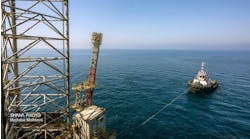A recent report by Moody’s Investors Services warned that the offshore drilling industry will remain under stress through 2017.
“The Worst Is Yet to Come for Offshore Drillers” notes that the oversupply of rigs combined with the stubbornly low oil price is putting severe pressure on day rates - with the credit rating of contractors being stretched as rig earnings and asset values decline.
Around 75% of the 72 newbuild floating rigs and 90% of the 117 jackups on order are due for delivery by the end of 2017. However, only 50% of the floaters and less than 10% of the jackups have fixed employment upon delivery.
Until the recent downturn, offshore construction contracts were largely profitable ventures for both yards and rig contractors, with financing secured post-delivery against earnings under lucrative employment contracts. This arrangement allowed contractors to negotiate increasingly favorable terms with the yards, with the final delivery installment often as much as 90% (if not more) of the contract price. In addition, construction contracts were often entered into with special purpose companies (SPCs) established by the contractors with limited assets, rather than with or guaranteed by a corporation of any financial substance.
While such terms arguably stimulated contractors to build offshore rigs, the present slack demand from oil companies to employ these units has left many contractors unable to obtain take-out financing to pay the yards the remainder of the contract price and then take delivery of the rigs.
Failure by a contractor to pay the delivery installment is ostensibly an event of default under the construction contract, entitling the yard to terminate the contract and claim damages for any loss suffered. In the shipping industry, vessels are (relatively) homogenous and there is generally some form of re-sale market. However, that is not the case in the offshore sector’s current predicament, with the yard exposed to the risk of having built a highly specialized asset with diminishing value for an industry that currently has no use for it. With this in mind, the yard will wish to keep as many of its options open as possible against the contractor.
To an extent, each participant’s hand is forced. Contractors are unable to find employment for their rigs and hence obtain financing, while yards are struggling to find replacement purchasers for their rigs, even if the yard is in a position to terminate the construction contract for a contractor’s breach. As a result there have not so far been extensive terminations of rig contracts but rather renegotiations, with both parties largely agreeing to defer delivery until a future date when the market has hopefully improved.
Any deferral of the delivery date will also likely entail cooperation from the bank through which the shipyard has secured its refund guarantees, as the contractor will require those guarantees issued in respect of any pre-delivery installments to be extended accordingly. But the refund guarantors may prove reluctant to grant an extension if they perceive an increased risk of the shipyard entering insolvency.
Irrespective of whether the parties enter into renegotiations with one another or not, depressed market conditions generally result in more disagreements between parties than would otherwise occur in more affluent times. The incentive for a contractor to take delivery of a rig in order to start profitable operations is simply not there in a depressed market. Instead, the contractor may view routine issues that would ordinarily be resolved (such as minor deficiencies with the rig at the time of delivery) as an opportunity to delay delivery or even to terminate the contract. However, the contractor should be cautious about exercising any right to terminate, especially if the reason given for termination is disputed by the yard.
Should the contractor be found to have wrongfully terminated the construction contract, it may find itself facing a claim not only for any pre-delivery installments that it will already have paid but also for damages arising as a result of its default. A contractor may take the view that its exposure to damages will be limited to forfeiture of the pre-delivery installments, given that the yard’s only recourse is toward an SPC. However, this fails to take into account the possibility of the yard being able to “pierce the corporate veil” in certain jurisdictions when seeking enforcement against other members of the contractor’s group, and the reputational fall-out that may attach to the contractor as a result of such breach. In addition, the contractor (through other SPCs) may have other units under construction at the same yard, and may be either unwilling or unable to terminate these contracts, making its relationship with the yard even more difficult to manage.
Although the effects of the current market conditions have been widely reported, we are not yet seeing the wholesale project cancellations that perhaps were expected. It would appear that industry participants are all too aware of the cyclical nature of the market in which they operate, and, with choices limited, are prepared to work together in restructuring projects rather than to let them fail. Ideally, the upturn will come sooner rather than later for all participants in the offshore rig sector, to prevent any further escalation of disputes.
Joe McGladdery
Partner
Watson Farley & Williams LLP


